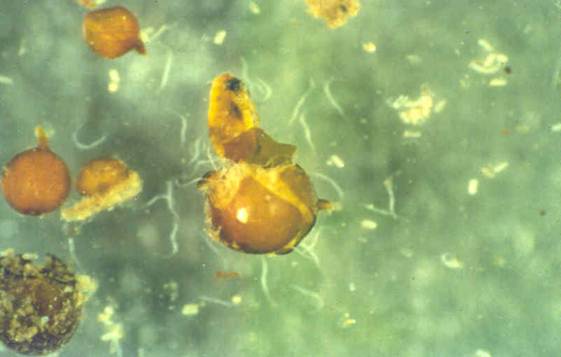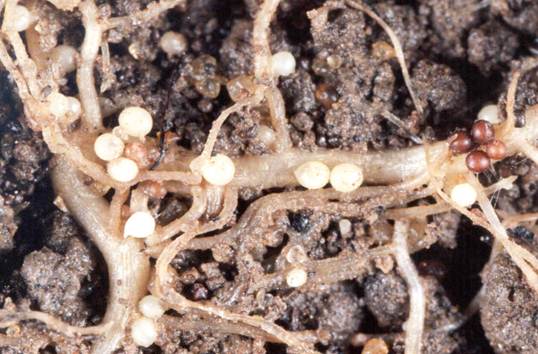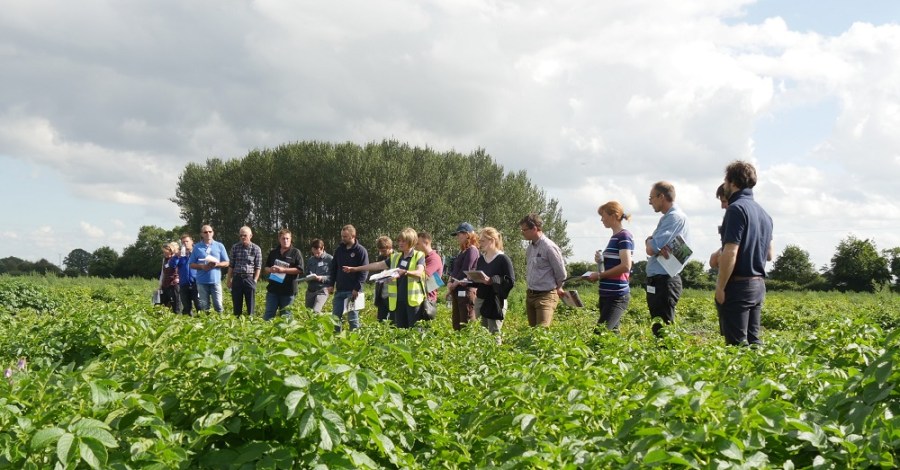Last month AHDB Potatoes held an open afternoon at its Strategic potato farm (SPot) in Shrops. CPM finds out how researchers are working to help a commercial potato farm with a huge PCN problem.
At the J3 juvenile stage, the nematode becomes either a male or female.
By Lucy de la Pasture
SPot farm West is unlike any of the other strategic farms. It has one focus and that’s on potato cyst nematode (PCN) and the chosen site at Heal Farm Estate, near Shawbury, has PCN numbers in epic proportions.
Heal Farm’s director, Matthew Wallace explains the main challenges they face are due to over-cropping of land, with PCN being a particular problem. The Estate farms 1800ha on a current rotation of approx. 600ha potatoes, winter barley, winter OSR, winter wheat before returning to potatoes.
Potatoes have historically been grown on a one in four or one in five rotation which has contributed to a build-up of PCN and free-living nematodes (FLN), but now the plan is to try to lengthen the rotation. Rented land is relied on for much of the farm’s processing potato production and the SPot farm demonstration site is a case in point, he explains.
New to his post last year, Matthew has inherited an unenviable problem, the demonstration field having a PCN analysis of up to 304 eggs/g in hotspots and a general population in the 60-100 eggs/g range. Globodera pallida, which is the more problematic PCN species, is dominant in the field.

Cysts can contain up to 500 eggs, which are stimulated to hatch by root exudates from a host plant.
“I invited AHDB to have a SPot farm here because I believe it’s an opportunity for us to find the best way to manage our PCN situation and become more sustainable, as well as generate a better return on the crop.”
The commercial crop planted in the SPot demonstration field is crisping variety, Arsenal – an early maincrop with resistance to both species of PCN, G. pallida Pa2 and Pa3 and G. rostochiensis Ro1, 3 and 4.
AHDB’s Dr Anne Stone begins by explaining the difference between PCN resistant and tolerant varieties. “Resistance is the ability of the plant to disrupt the lifecycle by preventing J3 PCN juveniles from maintaining syncytia, which are feeding cells in the roots of the host potato plants. But no variety is completely resistant to PCN,” she points out.
By contrast, susceptible varieties don’t have PCN resistance ge

Some varieties have resistance to PCN which prevents them from forming feeding cells (syncytia) on roots and so prevents multiplication.
nes, so nematodes are able to mature and subsequently feed and proliferate, causing root damage and a resulting loss in yield.
Tolerant varieties will produce yield and survive under nematode infestation, but don’t necessarily prevent a nematode population rising and so should be adopted on infested fields with caution. The danger being that tolerant varieties can lead a grower to underestimate a PCN infestation in a successive crop if it is not also resistant, she adds.
One of the SPot demonstrations looks at tolerance in PCN resistant varieties, with differences in tolerance especially apparent with such a high infestation of PCN, Anne explains.
“Innovator is one of the varieties which isn’t doing well at this site, even with a nematicide. It’s a very intolerant variety. If Innovator is grown to suppress PCN populations, it should only be planted where egg numbers are low, less than 2 eggs/g, and even then, use of a nematicide is important,” she notes.
“In contrast Royal is showing a good level of tolerance even at high PCN densities, though it’s rated 3 for resistance to G. pallida, lower than some other resistant varieties. We’ll see how it has performed in terms of resistance, measurable by the reduction in PCN egg numbers, after soil samples have been analysed at the end of the season.
“Eurostar, Alcander and Performer look to be performing equally well on nematicide-treated and untreated plots. This appears to indicate good levels of tolerance, although earlier in the season greater differences were apparent,” comments Anne.
“Arsenal never achieved complete ground cover in the demo and seems to have a medium level of tolerance, although the field crop surrounding the site has done remarkably well. Maris Piper was included as a ‘control’ variety. It’s tolerant to PCN and resistant to G. rostochiensis but not to G. pallida.”
In addition to the SPot demo, within the same site there’s a fully replicated Sustainable Agriculture Research and Innovation Club (SARIC) experiment, which is investigating the tolerance against PCN of the 10 most widely grown varieties in the UK, explains Bill Watts of Harper Adams University.
“It’s been necessary to use a stratified randomisation of plots rather than the conventional fully random method, to take a better account of the wide differences in densities of PCN across the experiment” he explains.
PCN populations will be tested again after harvest so that their multiplication can be calculated for the different potato varieties. The aim of the research is to provide new data sets that can be used to improve AHDB’s PCN calculator and is being carried out in conjunction with Leeds University, who will be generating new population and yield prediction models using the results.
Bill will also be establishing a repeat experiment next season and searching for a site with lower PCN densities over the winter in an attempt to complement this year’s data set, in order to produce more robust models.
The potato varieties under investigation include Estima, Lady Rosetta, Marfona, Maris Piper, Markies, Melody, Nectar, Pentland Dell, Royal and Taurus, with Cara and Maris Peer as tolerant and intolerant controls respectively. Visual differences in their haulm growth is very much in evidence in the trial.
Within the trial, Nectar is looking extremely good, while Maris Piper, Markies, Melody and Royal are nearly level with Cara in terms of haulm cover at the current time, even in the high population plots. The other experimental varieties appear to be coping better than would be expected under such high PCN densities (28-304 eggs/g), but stress symptoms are now evident in some varieties, including phosphorous deficiency and plant death, notes Bill.
“The tuber yield will be the true assessment of varietal tolerance to PCN though. SARIC results will be discussed later in the year alongside the SPot demo results,” he adds.
One of the ways growers can reduce the level of PCN infestation in fields is by using trap crops, suggests Andy Barker, director of Barworth Agriculture, a company which specialises in testing biological control methods.
The trap crops demonstrated at the Shawbury site include ‘Sticky Nightshade’ (Solanum sisymbriifolium), and ‘Black Nightshade’ (Solanum nigrum), along with two more solanums known as Azo and KBL.
Andy explains the concept behind trap cropping is to trigger nematodes to hatch, starting their life cycle, but then not allowing them to complete it. The most successful trap crops are resistant to PCN in the same manner as a highly resistant potato variety.
“Cysts are actually dead female nematodes and can contain from 0-500 viable eggs. In the presence of a solanaceous host, exudates from the roots trigger PCN eggs to hatch and juveniles (J2s) then invade the crop’s roots.
“At the J3 juvenile stage, the nematode becomes either a male or female. If PCN levels are high then a greater proportion become males and go back into the soil environment, where they move around in the rooting zone mating with the females which have become sedentary, feeding on the roots. PCN have a huge genetic range, with G. pallida being the most highly heterogenic of the two species,” he explains.
“Using potatoes as a trap crop is just too risky but there are other solanaceous species that we can use. S. sisymbriifolium is a thorned species and can be a nightmare to grow, with establishment sometimes tricky. But you don’t need a massive crop because the root exudates will have had the desired effect within the first six weeks of growth. A good root system is essential to trigger sufficient eggs to hatch within the soil profile,” he explains.
- nigrum can be used as an easier to grow alternative but has the problem that you can get PCN multiplication with some crops. Of the other alternatives, Andy highlights Azo as having significant potential as a species for trap cropping.
Bayer had their pipeline nematicide (AR83685) on display, which attracted interest from both growers and other nematicide manufacturers. Development manager Nigel Adam believes that the new treatment could prove to be complimentary to the existing granular nematicides currently under the watchful eye of regulators.
The demo showed untreated plots, the Bayer treatment alone and in combination with nematicides, either Nemathorin or Vydate. Bayer trials are showing some of the best results when the active ingredient, fluopyram, is used in combination with existing nematicide products and Nigel gave a strong indication that this may be how it could be used if approval is granted.
Nigel highlights the key benefits of fluopyram as being a unique mode of action for a nematicide, a low rate of use (250g/ha) and good environmental and mammalian toxicity profiles.
“Fluopyram is an SDHI and works by inhibiting ATP synthesis within the mitochondria of nematode cells so that they run out of steam,” he explains.
There are two ways growers will be able to apply the new liquid treatment. “AR83685 will be formulated as a liquid that can be applied as an overall treatment before bed formation, but needs to be sprayed then incorporated within three days of planting.
“Alternatively, it could be applied as an in-furrow spray treatment, in the same way that Amistar (azoxystrobin) is currently applied. Both methods have been shown to be effective, although in different situations, one method may be more effective than the other.”
Fluopyram belongs to the SDHI group of chemistry so begs the immediate question, does AR83685 also have any fungicidal activity against tuber diseases? Nigel explains that tests have shown fluopyram has no significant effect on Rhizoctonia, whilst other skin diseases have yet to be investigated.
“Fluopyram is active on alternaria (early blight) when applied as a foliar spray, but as a soil applied treatment for nematode control the dose applied is so low it’s not likely to be useful in this capacity,” he comments.
Perhaps of significant interest is an initial indication, from two trials, that AR83685 treatment seems to have a dramatic effect on FLN populations, causing a reduction in levels of Spraing infection. But more work needs to be carried out to investigate this further, stresses Nigel.
Dr Lydia Smith, head of Innovation Farm at NIAB-CUF, has experimented with mycorrhizal inoculation on different crops and is investigating whether the potato crop will benefit when growing in a PCN situation, where roots will be damaged by nematode feeding.
The four plots on display were untreated, inoculated with mycorrhizae, nemathorin treated and inoculated with mycorrhizae plus nemathorin treatment.
“Mycorrhizal fungi are free-living but form a close symbiotic association with their host, enabling the host to access phosphate in the soil which is in an unavailable form. In addition, mycorrhizae help with soil/water relations and help plants to fight off infections,” she explains.
“If good quality nutrients are already available to the crop then there will be less benefit from a mycorrhizal association. If nutrient availability is low then there’s the probability of seeing the benefit increase.
“When inoculated the hyphae of mycorrhizal fungi grows inside the roots of their host plants, termed arbuscular. The hyphae extend to double the area of the root mass, so plants can access a much larger soil volume and scavenge nutrients. Very little research has been carried out on farm systems with mycorrhizal fungi but research in Germany and the USA seems to be confirming that there’s a benefit, not just to the soil but also to the following crop.”




